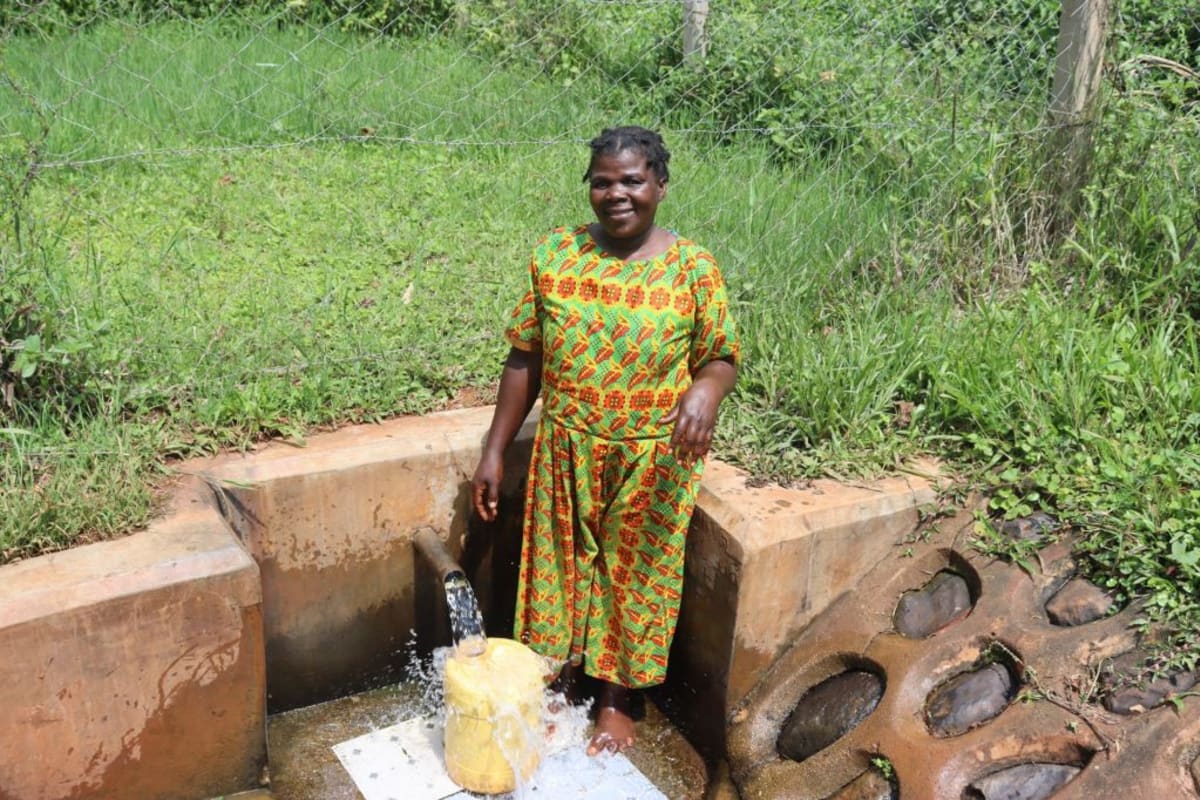When we first examined Mutovo Spring during our vetting survey, the spring was open and unprotected. When we returned, we learned that a local political aspirant had attempted to protect the spring. However, even though the construction of the protected spring was completed not long ago, problems are already arising with the spring, its water quality, and its continuing effect on community members' health.
The 800 community members who live in Shisasari Itumbu rely on Mutovo Spring as their only water source. People regularly make up to five trips a day to the water point and back, taking an hour each trip to collect water.
They are grateful that the spring provides sufficient water to meet their needs, but the quality of the water, even after the political aspirant's efforts, is questionable. Community members are still reporting numerous stomach problems after drinking the water, indicating it is still contaminated.

The area around the spring, especially the spring box where people collect water, is flooded. Water seeps through areas it shouldn't.
Layers of stone, gravel, tarp, soil, and grass should isolate the water from outside contaminants above the discharge pipe. Then the area would need to be fenced to protect the carefully arranged layers from compaction and contamination. There is no fenced filtration area. Instead, water soaks the grass above the spring box, and the cement is already crumbling.
The chlorine dispenser beside the spring serves as a resource to clean the water from the spring as well as the containers that people use to transport the water.
Another issue is that the spring remains difficult to access, putting people at risk of being injured while collecting water and walking up the steep embankment with heavy water containers.
"[I] am glad accessibility will be simple with your modern style of construction," said Cynthia T., 17 (pictured below at the spring).

With so many people depending on this waterpoint, this situation is not acceptable.

"This water point is serving people as far as two kilometers (1.24 miles) away," explained local businessman Plus Munyenya, pictured above at the spring. "They come with pickups, others with carts, just to get water."
Those who live in the community need the spring properly protected so they won't have to wonder if they risk becoming ill every time. And they need the spring to become more accessible, so they can save time and energy and know they can safely collect water without the danger of falling and injuring themselves.

Plus concluded by telling us that the community members are excited about our intervention. "We are happy [for you] to consider us for this project," he said. "We are ready. You are welcome anytime here at home and [in the] community."
What We Can Do:
Spring Protection
Protecting the spring will help provide access to cleaner and safer water and reduce the time people have to spend to fetch it. Construction will keep surface runoff and other contaminants out of the water. With the community's high involvement in the process, there should be a good sense of responsibility and ownership for the new clean water source.
Fetching water is a task predominantly carried out by women and young girls. Protecting the spring and offering training and support will, therefore, help empower the female members of the community by freeing up more of their time and energy to engage and invest in income-generating activities and their education.
Training on Health, Hygiene, COVID-19, and More
To hold trainings during the pandemic, we work closely with both community leaders and the local government to approve small groups to attend training. We ask community leaders to invite a select yet representative group of people to attend training who will then act as ambassadors to the rest of the community to share what they learn. We also communicate our expectations of physical distancing and wearing masks for all who choose to attend.
The training will focus on improved hygiene, health, and sanitation habits in this community. We will also have a dedicated session on COVID-19 symptoms, transmission routes, and prevention best practices.
With the community's input, we will identify key leverage points where they can alter their practices at the personal, household, and community levels to affect change. This training will help to ensure participants have the knowledge they need about healthy practices and their importance to make the most of their water point as soon as water is flowing.
Our team of facilitators will use a variety of methods to train community members. Some of these methods include participatory hygiene and sanitation transformation, asset-based community development, group discussions, handouts, and demonstrations at the spring.
One of the most important issues we plan to cover is the handling, storage, and treatment of water. Having a clean water source will be extremely helpful, but it is useless if water gets contaminated by the time it is consumed. We and the community strongly believe that all of these components will work together to improve living standards here, which will help to unlock the potential for these community members to live better, healthier lives.
We will then conduct a small series of follow-up trainings before transitioning to our regularly scheduled support visits throughout the year.
Training will result in the formation of a water user committee, elected by their peers, that will oversee the operations and maintenance of the spring. The committee will enforce proper behavior around the spring and delegate tasks that will help preserve the site, such as building a fence and digging proper drainage channels. The fence will keep out destructive animals and unwanted waste, and the drainage will keep the area's mosquito population at a minimum.

 Protected Spring
Protected Spring
 Rehabilitation Project
Rehabilitation Project




































